Reviews
Ben Davis Selects the Most Important Art Essays of the Year
"Women on the Verge" and more essays that mattered in 2015.
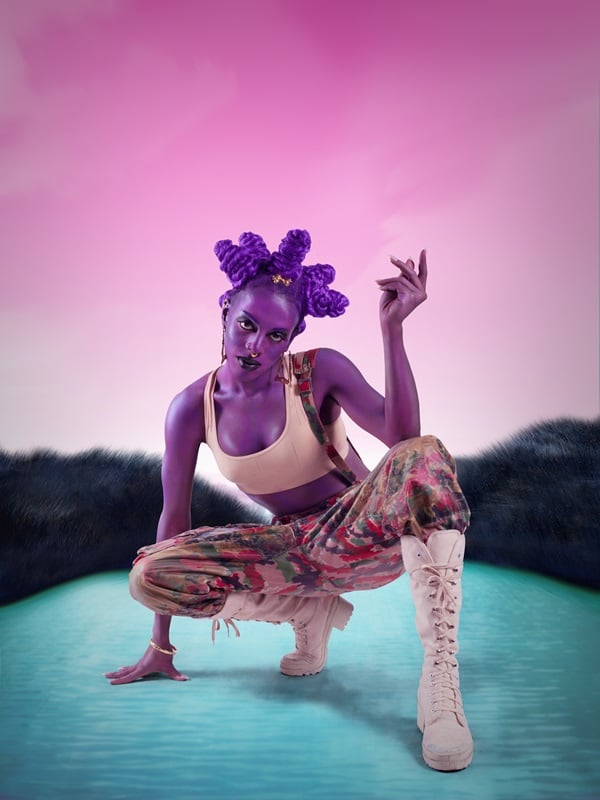
"Women on the Verge" and more essays that mattered in 2015.

Ben Davis

This time last year, my editor asked me to put together a list of the most important essays of 2014, and I drew a blank.
I asked around. By far the most common answer I got from peers was, “Nothing comes to mind.” Even the professionals, who’ve got their eyes glued to this stuff like Malcolm McDowell in A Clockwork Orange, have trouble keep track amid the digital crush of “content.”
In the end, I culled a list of essays from last year that I thought were worth bookmarking. Still, the exercise made me think about the value of reflecting on what is worth saving. So this year I’ve tried to write a column each month remarking on some of the writings that I liked from around the web (I miss a lot of stuff that’s only available in print, I know, but I want to at least provide a resource that artnet News readers can use).
While I can’t say that I’ve even come near to picking through the volume of material produced each month, I can say that every time I engage in the exercise, I discover gems that I would have missed otherwise, like Esther Honig’s article about the price of having art go viral in the great New Orleans website Pelican Bomb, or new publications that are doing fascinating work, like BMore Art from Baltimore or Infinite Mile from Detroit.
Below, a few of the essays that I’m still thinking about at the end of the year.
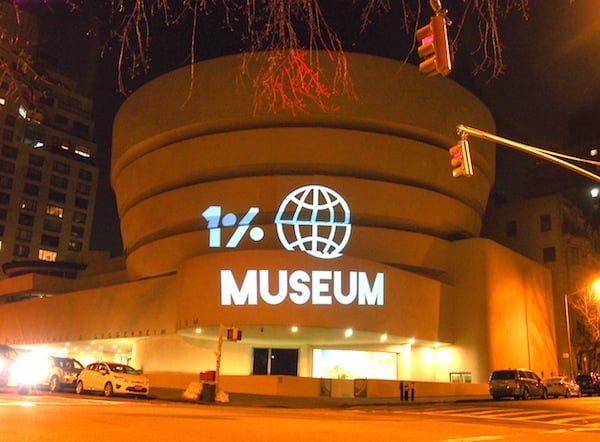
The Illuminator’s projection on the Guggenheim Museum.
Courtesy the Illuminator.
1. “Almost one third of solo shows in US museums go to artists represented by just five galleries” by Julia Halperin, The Art Newspaper
Halperin’s exercise in data journalism (with data analysis via Nilkanth Patel), is based on 600 exhibitions at 68 museums. It turned up the outsized presence of Gagosian Gallery, Pace, Marian Goodman Gallery, David Zwirner, and Hauser & Wirth. What this bias means is more controversial, but this article definitely got people talking about the conveyor belt that connects inequalities within the market to those at the museums.
Key passage:
In the run-up to a major solo show, galleries often provide curators with access to archival images, pay shipping costs, pre-order hundreds of catalogues and help to finance the opening reception, according to sources. “If a major museum is flirting with a show, we’ll play ball as much as we have to,” says one director of a medium-sized US gallery.
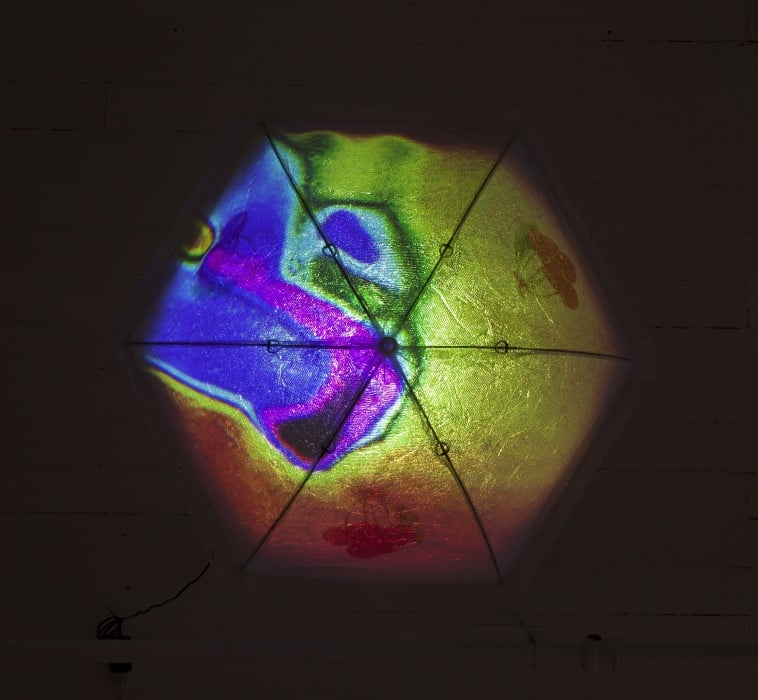
Amy Lien and Enzo Camacho, Nipple Stimulation 2 (2014), one of the subjects of Chris Kraus’s essay on art school.
Image: Courtesy 47 Canal.
2. “Chris Kraus on the Ambiguous Virtues of Art School” by Chris Kraus, Artspace
Kraus, the author of I Love Dick, is a legend in her time. This essay (an except from Phaidon’s collection of essays about art school, Akademie X: Lessons in Art + Life) shows why, merging personal anecdote, theory, and political reflection. Kraus’s theory that contemporary art has become the lint trap for culture, catching scraps from other disciples and fusing them into a new substance (my formulation), made this the essay that I recommended to people most this year.
Key passage:
One of art criticism’s great limitations is its inability to look beyond its own context and language. Why would young people enter a studio art program to become teachers and translators, novelists, archivists, and small business owners? Clearly, it’s because these activities have become so degraded and negligible within the culture that the only chance for them to appear is within contemporary art’s coded yet infinitely malleable discourse.

Containers in the yard of Natural Le Coultre, Ports Francs, Geneve.
Photo: Hito Steyerl. Image courtesy of e-flux.
3. “Duty-Free Art” by Hito Steyerl, e-Flux Journal
Like Kraus, Steyerl is tough to categorize; her free-form, sharply critical writing and her disorienting and erudite video essays form parts of a whole. In this piece (originally commissioned as an address at Artists Space) she looks at the free port—tax-free havens where art is stored—as a metaphoric lens through which to look at contemporary art amid the instability and chaos of the year.
Key passage:
The freeport contains multiple contradictions: it is a zone of terminal impermanence; it is also a zone of legalized extralegality maintained by nation-states trying to emulate failed states as closely as possible by selectively losing control. Thomas Elsaesser once used the term “constructive instability” to describe the aerodynamic properties of fighter jets that gain decisive advantages by navigating at the brink of system failure. They would more or less “fall” or “fail” in the desired direction. This constructive instability is implemented within nation-states by incorporating zones where they “fail” on purpose. Switzerland, for example, contains “245 open customs warehouses,” enclosing zones of legal and administrative exception. Are this state and others a container for different types of jurisdictions that get applied, or rather do not get applied, in relation to the wealth of corporations or individuals? Does this kind of state become a package for opportunistic statelessness?
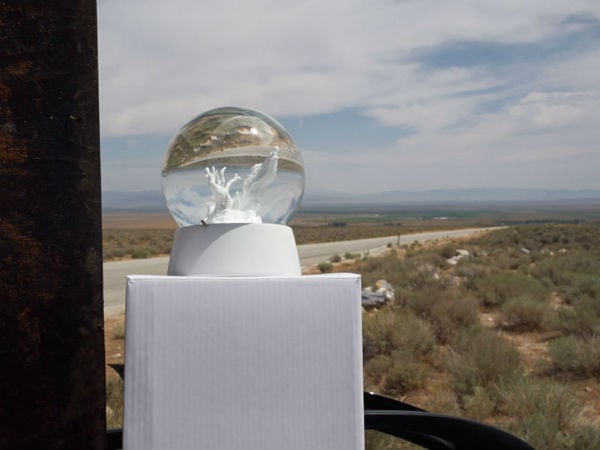
A snow globe, sole as part of Jeff Weiss’s “Prometheus” project
Photo: Courtesy Jeff Weiss
4. “The Ghost of Prometheus: A Long-Gone Tree and the Artist Who Resurrected Its Memory” by Carolina Miranda, The Los Angeles Times
This one made it to the front page of the LA Times, which is a rare achievement for an art story—particular one like this, that is neither about money nor scandal, but about art pursued as a pure intellectual passion. The specific subject is Jeff Weiss, whose tribute to Promentheus, a 5,000-year-old bristlecone pine that was felled in the name of science, becomes also a salute to the pungent realms of art that still persist at the fringes.
Key passage:
There aren’t too many people in the art world like Weiss. Wiry, charismatic and voluble, he’s an artist who knows a lot of people yet chooses to occupy the fringes. A former art professor (he’s taught at UCLA and the Rochester Institute of Technology), he’s been exhibited in galleries and museums over a five-decade career. But these days, at the age of 72, he doesn’t have much interest in a system he feels has become relentlessly commercial.
“I don’t do galleries,” he says, “and I don’t ‘show.'”
His venue of choice is the Galley, the 80-year-old Santa Monica bar and grill known for its exuberant seafaring theme of fishnets and pufferfish lighting fixtures. It was at the Galley where Weiss and several friends he dubs his “accomplices” planned the remembrance ceremony for the “Prometheus Project.”
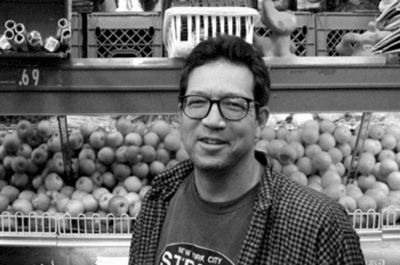
Sesshu Foster
Image: via www.poetryfoundation.org
5. “How is the artist or writer to function (survive and produce) in the community, outside of institutions?” by Sesshu Foster, East Los Angeles Dirigible Transport Lines
Foster stirred things up this year, causing debate with his criticism of the “Made In LA” biennial, and being dubbed by Al-Jazeera as the “the poet laureate of a vanishing neighborhood.” This long poem amounts to a personal manifesto about class, race, and creativity in a gentrifying city.
Key passage:
You, young artist, young writer. Go anywhere you like. But know that a community was there before you—this land was not a magically unpeopled wilderness to be colonized but a place of history, secrets, struggles, heroes and issues. What made it a community was not magic, but labor. Maybe if your labor and your work relates to them, if your aesthetic process is open to that community, your work will not be superfluous. Your work might be useful. You may not have to suddenly flee, like a tourist from the off-season. As an artist or writer anywhere, you’ll need community to survive. Your community-building not only helps you survive, it helps you produce.
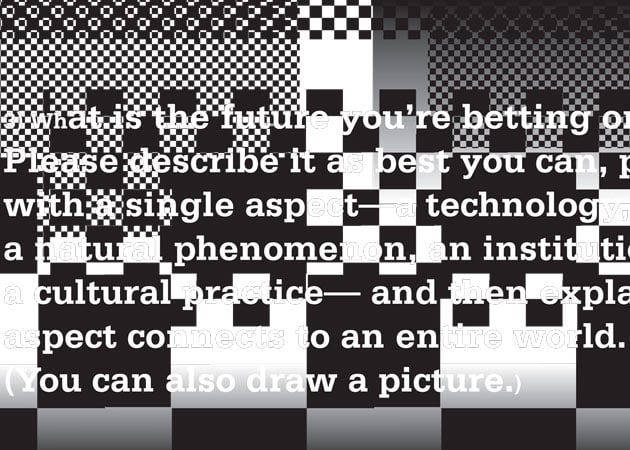
José León Cerrillo, Speculation Table #3 (detail) (2013)
Image: via canopycanopycanopy.com
6. “A Note on the Long Tomorrow,” Sarah Resnick, Triple Canopy
Utopia was a theme of the year (see also science fiction author China Miéville’s terrific “The Limits of Utopia” in Salvage or my own “Art and the Ecological” from the Miami Rail). Resnick’s lovely, discursive essay on the despairing tone of cultural theory and the false utopias of Silicon Valley is well worth reading as a summary of the intellectual moment. Even better, it is the pendant to Triple Canopy’s archive of “Speculations” about the future by celebrated thinkers and artists, organized at MoMA PS1 last year.
For fans of the future, there’s a lot to read.
Key passage:
I had no interest in pathologizing technology or innovation, which struck me as yet another form of resignation, but I was bothered by the notion that the future was being designed by a small subset of the population, dominated by recent graduates of elite engineering programs, that seemed to harbor little interest in the potential contributions of the rest of us. They employed a specialized language to describe their future, which excluded anyone who isn’t an engineer or coder…. I read these elated tweets and the blogs congratulating their authors and felt disempowered. At the same time, surveying Silicon Valley’s reveries suggested that constructing images of alternative worlds has an essential social function, and that it can symbolize—even determine—the agency of the constructors.
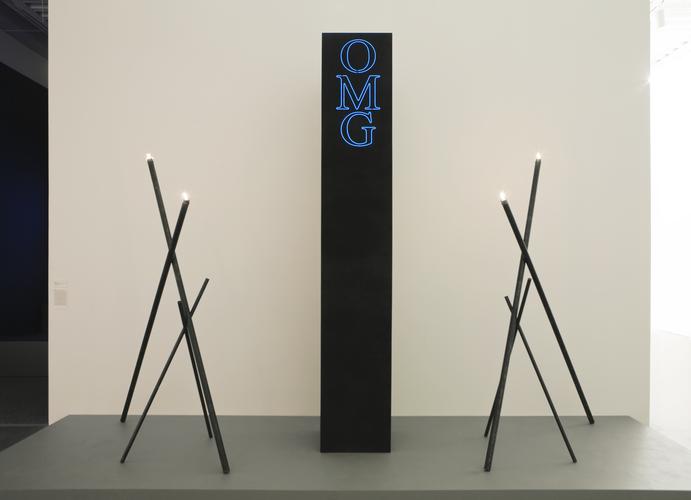
AIDS-3D’s OMG Obelisk in the New Museum Triennial
Image: Courtesy New Museum
7. “Q/A Nik Kosmas: “Why did you decide to end your career as a young and successful visual artist?” by Nik Kosmas, Spike
Perhaps the most interesting verdict yet on “post-Internet art,” from Kosmas, formerly one half of the hot art collective AIDS-3D, who has decided to leave the art world behind altogether.
Key passage:
As a member of the collective AIDS-3D, I belonged to that genre of art called Post-Internet, which had something to do with “discussing the digital lifestyle and implications …”. At first we did this with a witch-house post-apocalyptic tech-dystopia flavor, but then this evolved into projects like The Jogging and a lot of sculptures of running shoes, water droplets, and lots of cheap stuff stacked or melted on top of each other and sold in big editions for €3k-12k. I just didn’t think there was a point or a respectable future in endlessly critiquing or arrogantly joking about innovations coming from other fields.
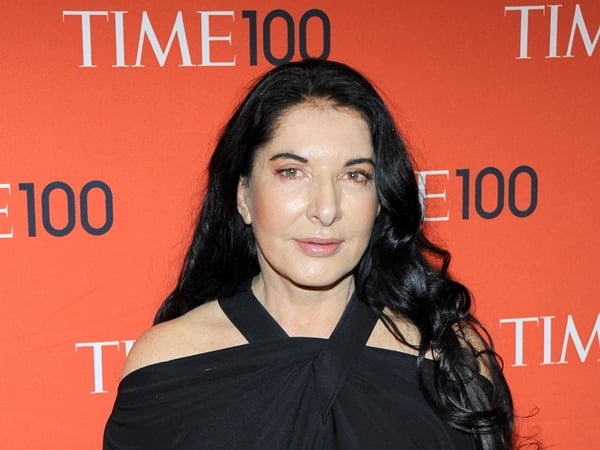
Marina Abramović.
Photo: © 2014 Patrick McMullan Company, Inc.
8. “Taking the Measure of Sexism: Facts, Figures, and Fixes” by Maura Reilly, ARTnews
In May, ARTnews editor-in-chief Sarah Douglas launched a special issue on feminism in the art industry, featuring thoughts on the subject from a wide swath of female artists. Curator and writer Maura Reilly’s centerpiece, summarizing the statistics around gender parity in the market, biennials, galleries, and more, will be a reference point on the subject for some time to come.
Key passage:
The common refrain that “women are treated equally in the art world now” needs to be challenged. The existence of a few superstars or token achiever—like Marina Abramovic, Tracey Emin, and Cindy Sherman—does not mean that women artists have achieved equality. Far from it.

Guggenheim Museum in Bilbao
Photo: Wikemedia Commons
9. “Toward a Museum of the 21st Century” by Holland Cotter, The New York Times
Cotter lays out the demands that a contemporary art museum would have to answer, and proposes that a “21st-century paradigm” is missing.
Key passage:
Museums like the Met are themselves grand history-writing-and-editing machines. Spectacle is built into them. But if they’re going to become 21st-century institutions, they’re also going to have to function in the mode of university teaching museums. Experimental—interdisciplinary, cross-cultural, self-critical, heterodox—approaches to art will have to be tried out if an audience for history, which is only as alive as our sense of investment in it, is not to be lost.

Amalia Ulman.
Photo via: @amaliaulman Instagram.
10. “Women on the Verge” by Johanna Fateman, Artforum
A vibrant and well-observed survey of the debates, doubts, and artistic strategies informing a generation of female artists whose formative experiences have come via social media culture.
Key passage:
If to put an image of one’s body on the Internet is to frame it with the apparatus of porn, to lose control of its circulation, and to expose oneself to the cultural anxiety, sexist scrutiny, and confounding hostility that attend the gesture, then what’s the way forward? There’s no single path, of course. But in many of the standout works that have emerged from this scene, young women—in registers of resignation or defiance, didactically or through performing the intertwinements of “sexuality, innocence, darkness, complacency”—seem to pull off the paradoxical feat of taking back their images at the very moment of surrender.